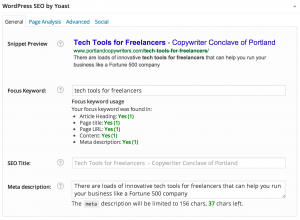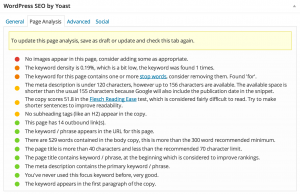When I was working for a tech company a few years ago, I was asked to write weekly blog posts. The client loved the first post I wrote. The third-party marketing expert the client was contracting at the time had some additional feedback about how to write a blog post for optimal SEO (search engine optimization). Here’s what I learned from him.
Where the SEO Should Go
To appease Google Almighty, you must write a post that’s about what you say it’s about, and title it according to the content. (Or write the content according to the title if that’s how you write. Either way is fine, just make sure the title of the post accurately reflects the content and vice versa.) If you do this consistently, Google will remember that you are a faithful follower, and continue to reward you with even higher search rankings.
There are six key areas of a blog post that increase the post’s ability to appear high and often in search results:
- Focus Keyword
- Meta Description
- SEO/Blog Post Title
- Subheadings (H2 tags and H3 tags primarily)
- Content of the Post
- Image Descriptions/Captions
Pick the main keyphrase that the post is about. Likely it will include some of the exact sequence of words found in the title.
This is the text under the title in a search result. It helps inform the reader about the relevance of this post to what they’re searching for. In order for this to be used effectively, the exact focus keyword/keyphrase you’ve should be in here.
You can completely customize the URL of a blog post. Meaning it should be SEO candy. It should inform the reader exactly what to expect in the blog post. Try to use words and phrases that readers would actually type into a Google search.
The H2 and H3 tags are your subheading tags within the post. These are excellent sources of SEO. They can include your focus keyphrase or additional information about your topic that lends credibility to your knowledge of the subject (Google loves you), and also helps break up the text and locate the reader within the post. It makes for a much more enjoyable reading experience (readers love you). Here’s more on the differences.
If the title of the post accurately reflects the content, the exact same sequence of words that appear in the title should also appear in the body of the post. Similar variations of the word sequence should also appear, but not too many. Google has made overloading keywords into a post a punishable offense (i.e. you fall from grace and your blog and website are no longer held in favor).
If you’re inserting an image into a blog post (which is usually always an excellent addition to a post) be sure to add a relevant, keyword-rich description on the backend (for sure) and a relevant, keyword-rich caption on the reader-facing side (if it’s right for the post). These are opportunities to insert evermore keywords into your post, AND if your image doesn’t show up for some reason (weird server stuff, broken link, etc.) at least the description of the image will appear, and your reader will know what it’s supposed to be.
A Blog Post is Not an Article
Blog posts should not be written like articles (i.e. text, text, and more text with no subheadings). The established blogging format is to have multiple headings (H2 or H3) throughout the post–one every two-three paragraphs will do. As mentioned earlier, these headings should contain keywords and sum up the copy that follows (like little newspaper headlines). Google is looking at these for clues as to what the content is about.
How to Know if You’ve Got Good SEO
There are a number of plugins you can install that will support your SEO efforts. Personally, I’m a huge fan of Yoast: a WordPress SEO plugin. It’s what we use to optimize the CC: PDX blog posts and it basically holds your hand through each post: telling you what’s wrong, how you can improve it, and how your posts rate.
To give you an idea of how helpful Yoast (and I’m sure other plugins are great too) is to a blogger, here’s what the backend looks like:
It puts all the SEO boxes you need to fill in all in one place. It even tells you how well you did using the focus keyword/keyphrase. If you missed something, those green yes’s would be red no’s. This is great because it allows you to tweak your content until you hit the right SEO sweet spot.
The Page Analysis tab gives you a more detailed description of what you’ve done well in the post and what you could improve upon. This post has more green lights than orange and red. Success! That’s good enough for us. If you’re a perfectionist who needs to hit green on everything every time…Yoast can help you get there.
The Benefits of SEO
All this search engine optimization of your blog posts helps increase the audience who’ll read them. What you want is for Google to know what the post is specifically about, and decide that your post is high quality enough to return it in the results of a visitor’s keyword search.
A few other SEO things I didn’t touch on are the tags and categories you can add to the backend of your posts, and keyword research tools like Google AdWords. Do explore these areas.
A Word About Yoast

In addition to being an awesome WordPress plugin, Yoast also has a robust blog that goes in depth about each of the areas we discussed above and much much more about SEO. If you’re using WordPress, my best advice is to install Yoast, blog, and learn by experimentation. There’s an art to blogging, but there’s also a science to it. The more you know about both sides of the coin, the more powerful a blogger you’ll be. (And no, I’m not a Yoast affiliate. Just a true believer.)
Is there anything else about blog post SEO that should be included here? SEO hacks, useful articles, tools, or resources?


